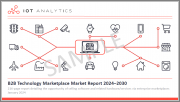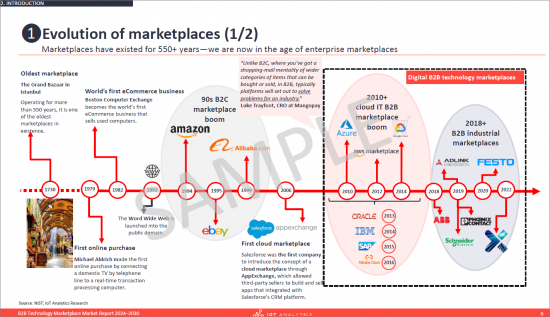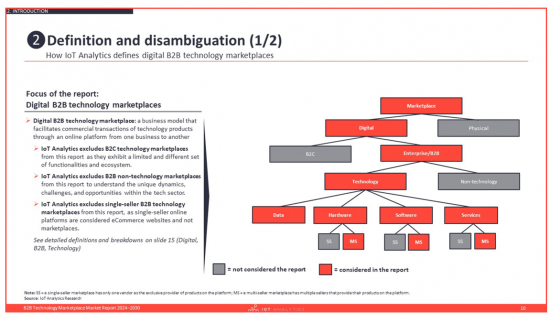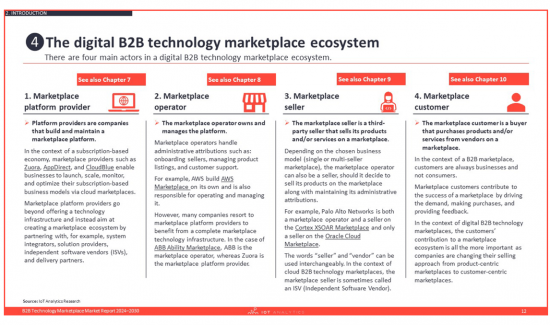
|
시장보고서
상품코드
1410438
B2B 기술 마켓플레이스 : 시장 분석(2024-2030년)B2B Technology Marketplaces Market Report 2024-2030 |
||||||
기업용 마켓플레이스를 통한 소프트웨어 및 하드웨어/서비스의 판매 기회에 대해 분석했으며, 100건의 마켓플레이스와 50사의 마켓플레이스 플랫폼 프로바이더 리스트를 제공합니다.
샘플

이 보고서는 IoT 소프트웨어 및 플랫폼에 대한 IoT 애널리틱스의 지속적인 연구의 일환입니다. 이 보고서는 2023년 5월부터 12월까지 실시된 다수의 설문조사, 2차 조사, 정성적 조사(클라우드 전문가, 판매자, 최종사용자 인터뷰)의 결과를 바탕으로 작성되었습니다. 이 보고서에는 B2B 기술 마켓플레이스의 정의, 마켓플레이스 플랫폼 프로바이더, 채택 촉진요인, 경쟁 환경, 주요 트렌드와 동향, 사례 연구 등이 포함되어 있습니다.
이 보고서의 주요 목적은 시장의 정의, 규모 측정 및 분석을 통해 독자들이 B2B 기술 시장 현황에 대한 이해를 높이는 데 있습니다.

디지털 B2B 기술 마켓플레이스란?
디지털 B2B 기술 마켓플레이스는 기술 제품의 기업 간 상거래를 가능하게 하는 온라인 플랫폼입니다. 기술 제품에 특화되어 있으므로 다른 B2B 마켓플레이스와 차별화됩니다.
디지털 B2B 기술 마켓플레이스는 현대 첨단 기술 산업의 중요한 컴포넌트입니다. 기업이 기술 제품을 거래할 수 있는 플랫폼을 제공하여 이 분야의 성장과 혁신에 기여하고 있습니다. 그 영향과 잠재력을 충분히 이해하기 위해서는 더 많은 연구와 분석이 필요합니다.

B2B 테크놀러지 마켓플레이스에 대한 지출
소프트웨어가 가장 빠르게 성장하는 카테고리로 부상하고 있습니다. 이러한 급격한 성장은 클라우드와 SaaS(Software as a Service) 솔루션의 확산에 힘입은 바 큽니다.
하드웨어가 2022년 B2B 기술 시장 지출의 절반 미만을 차지하며 완만한 성장세를 보이고 있습니다. 이는 높은 초기 비용과 긴 제품수명주기 등의 요인에 기인합니다.
마지막으로 서비스의 성장률은 완만하지만 안정적입니다. 이러한 추세는 유지보수 및 지원을 포함한 '서비스형' 모델의 부상으로 인해 영향을 받고 있습니다.
이 보고서의 분석 내용
- 어느기술이 B2B 기술 마켓플레이스 구축에 사용되고 있는가?
- 대표적인 B2B 마켓플레이스는 어떤 것인가? 이용 사례는?
- 어떤 새로운 비즈니스 모델이 B2B 기술 마켓플레이스에서 허가되고 있는가?
- 현재 B2B 기술 마켓플레이스에서 소비되고 있는 금액은 어느 정도인가? 2030년에는 어떤 모습일까?
- 클라우드 마켓플레이스는 어떻게 차별화되고 있는가?
- 산업 자동화 판매자는 자사와 마켓플레이스를 어떻게 포지셔닝하고 있는가?
- 기업이 자체 B2B 기술 마켓플레이스를 개설·판매하는 것으로 어떤 이점을 얻고 있는가?
- B2B 기술 마켓플레이스의 동향과 과제는 무엇인가?
- 주요 B2B 마켓플레이스 플랫폼 프로바이더의 시장 점유율은 어느 정도인가?
언급된 기업
이 보고서의 분석 대상 기업 중 일부
|
|
|
목차
제1장 주요 요약
제2장 서론
- 마켓플레이스의 진화
- 정의와 명확화
- 이 보고서에서 다루는 디지털 B2B 마켓플레이스 운영자의 유형
- 디지털 B2B 기술 마켓플레이스 에코시스템
- 디지털 B2B 기술 마켓플레이스의 사용자 인터페이스 기능
- 디지털 B2B 기술 마켓플레이스 내역
제3장 기술 개요
- 마켓플레이스 아키텍처 요소 : 프론트엔드와 백엔드
- 디지털 B2B 기술 마켓플레이스 아키텍처
- a. 고객의 요망에 대한 대응
- b. 판매자의 통합
- c. 아키텍처 약식도
- 아키텍처 사례
제4장 비즈니스 모델 고려사항
- 성공하는 디지털 B2B 기술 마켓플레이스 비즈니스의 구축 : 주요 고려사항
- 고객 중심 주의의 중시
- 디지털 B2B 기술 마켓플레이스 제품의 정의
- 기존 재판매업자의 관여
- 적절한 판매채널 전략의 책정
- 판매자 B2B 기술 마켓플레이스 전략의 이해 및 영향력
제5장 마켓플레이스 도입의 촉진요인
- 마켓플레이스 도입의 일반적인 촉진요인
- 마켓플레이스 도입의 촉진요인 : 마켓플레이스 운영자의 경우
- 마켓플레이스 도입의 촉진요인 : 마켓플레이스 판매자의 경우
제6장 시장 규모와 전망
- 개요 : B2B 마켓플레이스 시장을 관찰하는 2개의 방법
- B2B 마켓플레이스 지출액(2020-2030년)
- B2B 기술 마켓플레이스 지출액(2020-2030년)
- B2B 기술 마켓플레이스 소프트웨어 지출액(2020-2030년)
- B2B 기술 마켓플레이스 플랫폼 지출액(2020-2030년)
- 주요 채택 관점
제7장 경쟁 구도 : 마켓플레이스 플랫폼 프로바이더
- 기타 B2B 마켓플레이스/E-Commerce 플랫폼
- B2B 마켓플레이스 플랫폼 프로바이더의 시장 점유율
제8장 선택된 마켓플레이스 운영자에 관한 인사이트
- 하이퍼스케일러
- 산업 자동화 벤더
제9장 마켓플레이스 판매자에 관한 인사이트
- 기술 판매자에게 기업용 마켓플레이스에서 판매하는 주요 이점
- 기업용 마켓플레이스에 출품시 판매자의 주요 목표 : 기업 규모별
- 기업용 마켓플레이스에 출품시 판매자의 이점과 단점
제10장 마켓플레이스 고객 채택에 관한 인사이트
- B2B 조달에서 마켓플레이스의 이용
- 조달 채널 : 마켓플레이스 매출의 점유율
- 소프트웨어 라이선스의 예산 제한
- 기업은 언제 마켓플레이스에서 조달하는가?
- a. 조달 프로세스가 단순한 경우
- b. 신뢰할 수 있는 마켓플레이스 거버넌스가 있는 경우
- c. 무료 트라이얼을 시행할 수 있는 경우
제11장 사례 연구
제12장 상세 분석 : IoT 마켓플레이스
- IoT 솔루션에서 B2B 마켓플레이스의 역할
- AWS와 Azure가 마켓플레이스에서의 발자국을 확대
- IoT 플랫폼내 공통 IoT 애플리케이션 마켓플레이스
- 엣지 마켓플레이스 건수의 증가
- 마켓플레이스는 클라우드로부터 엣지까지 아키텍처에서 주요 역할을 담당한다.
- IoT에 초점을 맞춘 마켓플레이스
제13장 동향과 과제
제14장 분석 방법과 시장의 정의
제15장 IoT Analytics 소개
KSA 24.01.30This publication analyses the opportunity of selling software and related hardware / services via enterprise marketplaces, including, a 216-page market report, list of 100 marketplaces and 50 marketplace platform providers.
SAMPLE VIEW

The “B2B Technology Marketplaces Market Report 2024-2030” is part of IoT Analytics' ongoing coverage of IoT software and platforms. The information presented in this report is based on the results of multiple surveys, secondary research, and qualitative research, i.e., interviews with cloud experts, sellers, and end users between May and December 2023. The document includes definitions for the B2B technology marketplace, marketplace platform providers, adoption drivers, competitive landscapes, key trends and developments, and case studies.
The main purpose of this document is to help our readers understand the current landscape of B2B technology marketplaces by defining, sizing, and analyzing the market.

What are digital B2B technology marketplaces?
Digital B2B Technology Marketplaces are online platforms that enable commercial transactions of technology products between businesses. These platforms are distinct from other types of B2B marketplaces due to their specific focus on technology products.
This analysis does not include B2C technology marketplaces. The functionalities and ecosystems of B2C marketplaces differ significantly from those of B2B marketplaces, as they are designed to cater to individual consumers rather than businesses.
Similarly, B2B non-technology marketplaces are not part of this discussion. The aim is to understand the unique dynamics, challenges, and opportunities within the technology sector.
IoT Analytics excludes single-seller B2B technology marketplaces from this report, as single-seller online platforms are considered eCommerce websites and not marketplaces.
Digital B2B Technology Marketplaces are a significant component of the modern tech sector. They provide a platform for businesses to engage in commercial transactions of technology products, contributing to the growth and innovation in the sector. Further research and analysis are required to fully understand their impact and potential.

There are four main actors in a digital B2B technology marketplace ecosystem
1. Marketplace platform provider
- Platform providers are companies that build and maintain a marketplace platform.
2. Marketplace operator
- The marketplace operator owns and manages the platform.
3. Marketplace seller
- The marketplace seller is a third-party seller that sells its products and/or services on a marketplace.
4. Marketplace customer
- The marketplace customer is a buyer that purchases products and/or services from vendors on a marketplace.
B2B technology marketplace spending
Software has emerged as the fastest-growing category. This surge is largely attributed to the widespread adoption of cloud and Software as a Service (SaaS) solutions.
Hardware, while accounting for less than half of the spending in B2B technology marketplaces in 2022, has experienced moderate growth. This is due to factors such as high upfront costs and longer product life cycles.
Lastly, Services have seen a steady, albeit slower, growth. This trend is influenced by the rise of "as-a-servic" models, including maintenance and support.
Questions answered:
- Which technologies are used for building B2B technology marketplaces?
- Which are the leading B2B marketplaces and some of their case studies?
- Which new business models do B2B technology marketplaces allow?
- How much is spent on B2B technology marketplaces today, and what will it look like in 2030?
- How do cloud marketplaces differentiate from each other?
- How do industrial automation sellers position themselves and their marketplaces?
- What benefits are companies seeing from opening their own B2B technology marketplace and from selling on a B2B technology marketplace?
- What are the trends and challenges when it comes to B2B technology marketplaces?
- How much market share do leading B2B marketplace platform providers have?
Companies mentioned:
A selection of companies mentioned in the report.
|
|
|
Table of Contents
1. Executive Summary
2. Introduction
- 2.1. Evolution of marketplaces
- 2.2. Definition and disambiguation
- 2.3. Types of digital B2B marketplace operators covered in this report
- 2.4. Digital B2B technology marketplace ecosystem
- 2.5. User interface features of digital B2B technology marketplaces
- 2.6. Digital B2B technology marketplace breakdown
3. Technology Overview
- 3.1. Marketplace architecture elements: frontend and backend
- 3.2. Digital B2B technology marketplace architecture
- a. Handling customer request
- b. Integrating sellers
- c. Architecture blueprint
- 3.3. Architecture examples
4. Business model considerations
- 4.1. Building a successful digital B2B technology marketplace business: key considerations
- 4.2. Focusing on customer centricity
- 4.3. Defining digital B2B technology marketplace offerings
- 4.4. Involving existing resellers
- 4.5. Developing suitable sales channel strategies
- 4.6. Understanding and influencing seller B2B technology marketplace strategies
5. Marketplace adoption drivers
- 5.1. General marketplace adoption driver
- 5.2. Marketplace adoption drivers for marketplace operators
- 5.3. Marketplace adoption drivers for marketplace sellers
6. Market size and outlook
- 6.1. Overview: Two ways to look at the market for B2B marketplaces
- 6.2. B2B marketplace spending 2020-2030
- 6.3. B2B technology marketplace spending 2020-2030
- 6.4. B2B technology marketplace software spending 2020-2030
- 6.5. B2B technology marketplace platform spending 2020-2030
- 6.6. Selected adoption viewpoints
7. Competitive landscape: Marketplace platform providers
- 7.9. Other B2B marketplace and eCommerce platforms
- 7.10. Market share of B2B marketplace platform providers
8. Insights on selected marketplace operators
- 8.1. Hyperscalers
- 8.2. Industrial automation vendors
9. Insights on marketplace sellers
- 9.1. Key benefits of selling on enterprise marketplaces for technology sellers
- 9.2. Sellers' main goals when listing on an enterprise marketplace based on company size
- 9.3. Sellers' pros and cons when listing on enterprise marketplaces
10. Insights on marketplace customer adoption
- 10.1. Usage of marketplace in B2B procurement
- 10.2. Procurement channels - Share of marketplace revenue
- 10.3. Budget limits for software licenses
- 10.4. When do companies procure on a marketplace?
- a. When the procurement process is simple
- b. When there is credible marketplace governance
- c. When they have the ability to do a free trial
11. Case studies
12. Deep-dive: IoT Marketplaces
- 12.1. The role of B2B marketplaces for IoT solutions
- 12.2. AWS and Azure increase their footprint with their marketplaces
- 12.3. IoT application marketplaces common within IoT platforms
- 12.4. An increasing number of edge marketplaces
- 12.5. Marketplaces play a key role in cloud-to-edge architectures
- 12.6. IoT-focused marketplaces









